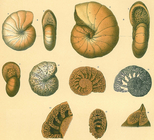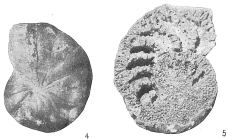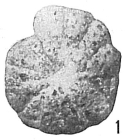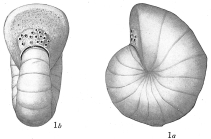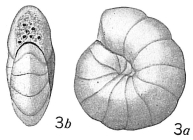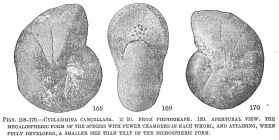RAS taxon details
Cyclammina Brady, 1879
112348 (urn:lsid:marinespecies.org:taxname:112348)
accepted
Genus
Cyclammina cancellata Brady, 1879 (type by original designation)
- Species Cyclammina cancellata Brady, 1879
- Species Cyclammina trullissata (Brady, 1879)
- Species Cyclammina pauciloculata (Brady, 1879) accepted as Cystammina pauciloculata (Brady, 1879) (No such species described by Brady. Mix up with Cystammina pauciloculata Brady, 1879)
marine, brackish, fresh, terrestrial
recent + fossil
feminine
Brady, H. B. (1879). Notes on some of the reticularian Rhizopoda of the "Challenger" Expedition; Part I. On new or little known arenaceous types. <em>Quarterly Journal of Microscopical Sciences.</em> 19: 20-67., available online at https://www.biodiversitylibrary.org/page/14704208
page(s): p. 62 [details]
page(s): p. 62 [details]
Hayward, B.W.; Le Coze, F.; Vachard, D.; Gross, O. (2021). World Foraminifera Database. Cyclammina Brady, 1879. Accessed through: RAS (Eds.) (2021) Register of Antarctic Species at: http://ras.biodiversity.aq/aphia.php?p=taxdetails&id=112348 on 2025-09-15
RAS (Eds.) (2025). Register of Antarctic Species. Cyclammina Brady, 1879. Accessed at: https://ras.biodiversity.aq/aphia.php?p=taxdetails&id=112348 on 2025-09-15
Date
action
by
2006-09-08 06:50:23Z
changed
Martinez, Olga
original description
Brady, H. B. (1879). Notes on some of the reticularian Rhizopoda of the "Challenger" Expedition; Part I. On new or little known arenaceous types. <em>Quarterly Journal of Microscopical Sciences.</em> 19: 20-67., available online at https://www.biodiversitylibrary.org/page/14704208
page(s): p. 62 [details]
basis of record Gross, O. (2001). Foraminifera, <B><I>in</I></B>: Costello, M.J. <i>et al.</i> (Ed.) (2001). <i>European register of marine species: a check-list of the marine species in Europe and a bibliography of guides to their identification. Collection Patrimoines Naturels,</i> 50: pp. 60-75 (look up in IMIS) [details]
additional source Neave, Sheffield Airey. (1939-1996). Nomenclator Zoologicus vol. 1-10 Online. <em>[Online Nomenclator Zoologicus at Checklistbank. Ubio link has gone].</em> , available online at https://www.checklistbank.org/dataset/126539/about [details]
additional source Asioli, A. (1995). Living (stained) benthic Foraminifera distribution in the western Ross Sea (Antarctica). <em>Paleopelagos.</em> 5: 201-214. [details]
page(s): p. 62 [details]
basis of record Gross, O. (2001). Foraminifera, <B><I>in</I></B>: Costello, M.J. <i>et al.</i> (Ed.) (2001). <i>European register of marine species: a check-list of the marine species in Europe and a bibliography of guides to their identification. Collection Patrimoines Naturels,</i> 50: pp. 60-75 (look up in IMIS) [details]
additional source Neave, Sheffield Airey. (1939-1996). Nomenclator Zoologicus vol. 1-10 Online. <em>[Online Nomenclator Zoologicus at Checklistbank. Ubio link has gone].</em> , available online at https://www.checklistbank.org/dataset/126539/about [details]
additional source Asioli, A. (1995). Living (stained) benthic Foraminifera distribution in the western Ross Sea (Antarctica). <em>Paleopelagos.</em> 5: 201-214. [details]
 Present
Present  Inaccurate
Inaccurate  Introduced: alien
Introduced: alien  Containing type locality
Containing type locality
